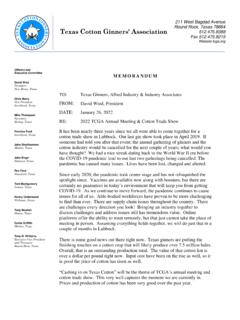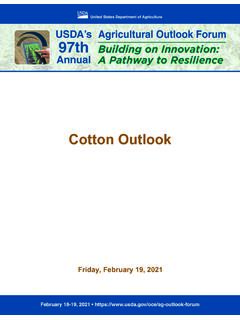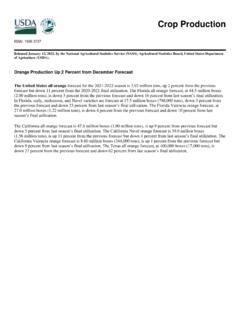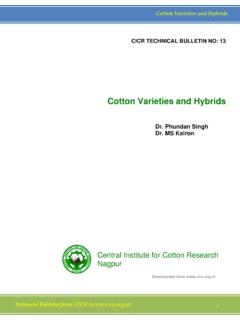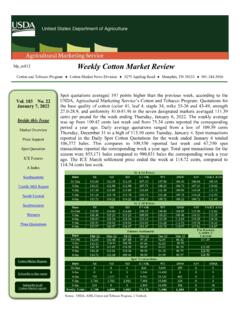Transcription of Nutrient deficiencies and their symptoms in selected crops
1 Nutrient deficiencies and their symptoms in selected cropsModified from Mike StewartGreat Plains DirectorPotash & Phosphate good sources of informationEssential and Beneficial Elements in Higher PlantsBennett, general types of Nutrient deficiency symptoms Chlorosis- yellowing due to reduction in chlorophyll Uniform or interveinal Necrosis-death of plant tissue Lack of new growth or terminal growth resulting in resetting Anthocyanin accumulation (when metabolic processes are disrupted) resulting in reddish color Stunting with either normal or dark green color or yellowingBennett, factors can affect occurrence of deficiency symptoms Soil test level also consider texture, CEC, OM, pH, etc.
2 Soil conditions, , temperature compaction moisture Salinity Tillage practices Root pruning Nutrient interactions P-Zn Herbicide, disease, or insect damageSoil pH and availability of nutrientsSoil pH and the secondary and micronutrients Soil pH influences solubility of compounds, hence Nutrient availability cations on exchange sites Common deficiencies on acid soils Ca, Mg, S, Mo Common deficiencies onalkaline soils B, Cu, Fe, Mn, ZnNutrient deficiency symptoms and mobility within plants Mobility- The ease with which an element is transported to new plant parts. The extent of mobility affects the appearance of deficiency Mobility in the PlantSymptoms appear in older leaves first nitrogen phosphorous potassium magnesiumSymptoms appear in younger leaves first sulfur calcium boron, iron, manganese, zinc, copper, molybdenum, chlorideTranslocatedNot translocatedGeneral symptoms -nitrogen Deficiency usually appears on older leaves first.
3 Because N is a part of the chlorophyll molecule, a major deficiency symptom is chlorosis. Slow growth and stunted plants Lower protein, fewer leaves, and early maturity In corn yellowing begins at leaf tip and extends along midribs. Less tillering in small grains and other grasses Reduced yield potentialGeneral symptoms -phosphorus symptoms will generally appear on older leaves first. Purple or reddish color Overall stunting Reduced tillering in small grains Reduced yield potential In many crops symptoms can be aggravated by conditions that restrict root growth ( , cool, moist, and/or compacted soils).General symptoms -potassium symptoms will generally appear on older leaves first.
4 Yellowing and/or scorching along leaf margins Weakened stalks (lodging) Decreased disease resistance Slow growth and poorly developed root system Small and shriveled grain or fruit Reduced yield potential In many crops symptoms can be aggravated by conditions that restrict root growth ( , cool, moist, and/or compacted soils).CottonN management of cotton Uptake may reach 2-4 lb/A/day during mid boll fill Approximately 20% of seasonal needs should be supplied pre-bloom Supply remainder of N should be supplied during boll development period Soil N should be depleted as bolls begin to open to avoid delayed maturityDry Matter Accumulation, and Nitrogen and Phosphorus Uptake of cotton Time (Days)0306090120150 Maximum Accumulation (%)020406080100 Dry weight and phosphorusNitrogen* First Square* First Flower* Peak Bloom* First open boll* 20% open boll * 50% open bollD.
5 KriegN deficient cottonEarly and mid season Yellowish-green leaf color and small young leaves Stunted plants Shortened fruiting branches Many bolls shed in the first 10-12 days after floweringLate season Reddening in the middle of the canopy Reduced boll retention at late fruiting positions Shorter flowering period, accelerated leaf senescence, and early cut-outFunctions of Phosphorus in cotton production Promotes early boll development and hastens maturity Essential for vigorous root and shoot growth Helps overcome the effects of compaction Increases water use efficiency A 2 bale crop can take up more than 50 lb P2O5/AP deficient cottonSymptoms are not distinct in cotton , Stunting Dark leaves Flowering delayed Poor boll retention Premature leaf senescencePotassium in cotton production Bolls are major sinks for K, uptake may peak at as much as 3-4 lb K2O/A/day during boll development.
6 About 70% of total uptake occurs after first bloom. Affects quality (micronaire, length, and strength) Increases water use efficiency Reduces the incidence and severity of wilt diseases A 2 bale crop will take-up about 170 lb K2 OPotassium deficient cotton Affects older leaves first in early season Begins as scorching of leaf margin Affects both yield and quality Late season affects younger leavesLate season K deficiency of cottonFoliar K on cotton The foundation of K fertility program should be soil applications. Response to mid-season foliar K is likely when soil K is low (low soil test level or fixation) root uptake is compromised petiole analysis indicates a pending shortage Applications at 2 week intervals should begin at or soon after 1st flower 5 lb K2O/A per applicationSulfur deficient cotton symptoms similar to N but occur on younger leaves in upper canopy first Leaf veins tend to remain greenMg deficiency in cotton Appears on older leaves first Distinct interveinal reddish purple colorCornPhosphorus deficiency in corn Purple or reddish color in older leaves Most often occur in young plants Overall stunting that may persist throughout season Lower yieldEffect of P on hastening corn maturityK deficiency in corn Scorching
7 (necrosis) along leaf margins of lower leaves first Weakened stalks that may result in lodging Decreased disease resistance Slow growth Reduced yield potentialK shortages can weaken stalks and result in lodgingSulfur deficiency in corn Chlorosis similar to N but occurring on younger leaves first Delayed maturity Stunting Favored in sandy, acid soils low in OM, and cold wet deficiency in corn Yellow to white intervienal chlorosis on older leaves first Leaves may become reddish-purple In severe cases leaf tips and edges may die Favored by sandy, acid soils where Mg nas been leached Deficiency can be induced by imbalance with KZn deficiency due to P-Zn interactionPhoto P-Zn InteractionsPottawatomie Co, KS80 lb P2O5-Banded0 Zn80 lb P2O5-Broadcast0 Zn80 lb P2O510 ZnWheatP deficiency in wheat Slow growth and reduced tillering Late maturity and reduced yields Increased disease susceptibilityP deficiency in tillering, delays maturity, and lowers yieldS deficient wheat Brightly chlorotic, yellow-green and stunted plants.
8 Most common on coarse, well-drained soils low in organic matter. In season deficiency best treated with sulfate source and not elemental SSome micronutrient symptomsZi nc (Zn)Corn- Broad white to yellow bands on each side of Interveinal yellowing with distinct green Stunted stems and chlorotic interveinal areas. Slowed maturity and reduced seed (Fe)Corn- Interveinal areas become pale green to Interveinal yellowing with distinct green Yellowing of interveinal areas. Whole leaf finally turns white. May be induced by (Mn)Corn- Rarely occurs. symptoms are not Rarely occurs. Leaf cupping and interveinal Interveinal areas become light green to white.
9 Veins remain prominently (B)Corn- Rarely occurs. Leaves are brittle with small dead Short, thick petioles with dark concentric bands along their length. Distorted flower shape. Flower and boll Shortened internodes and yellowing or reddening of upper leaves. Death of terminal growth. Flowers fail to , deficiency symptomsCottonSoybeanCornCornIron deficiency symptomsSoybeanCornManganese deficiency symptomsCottonSoybeanSoybeanSummary The ability to accurately diagnose Nutrient deficiencies is an important skill. Deficiency symptoms are often not clearly defined. Masking effects can hinder diagnosis. The entire system should be evaluated before making a diagnosis and recommendation.
10 Use soil, irrigation water, and plant analyses to aid in diagnostic efforts. Summary Visual symptoms indicate severe starvation. Most crops start losing yields well before deficiency symptoms occur. In most c ases in-season corrective applications can avoid further yield loss. A well-planned, complete and balanced fertility program can prevent in-season yield robbing Nutrient deficiencies . Improving soil quality improves crop quality











